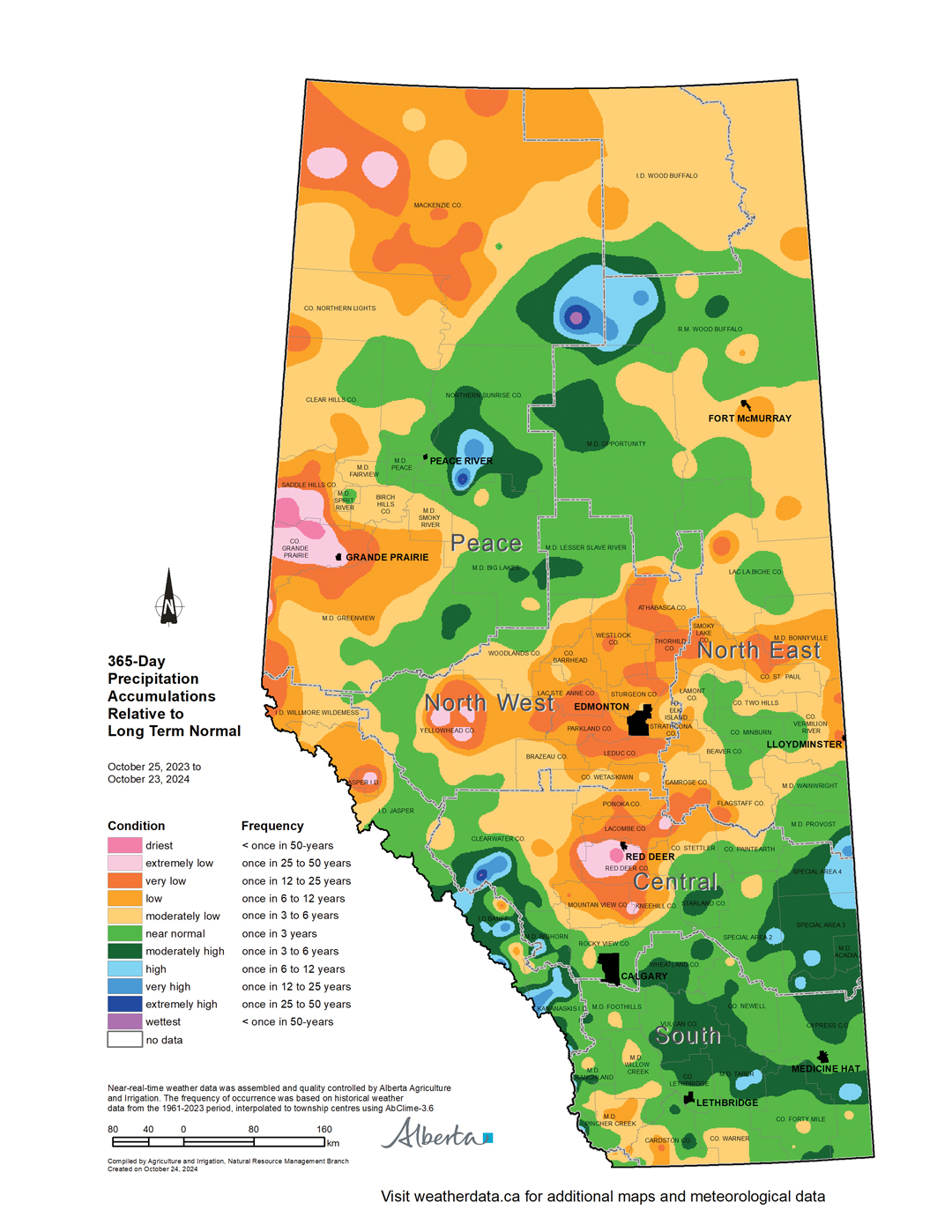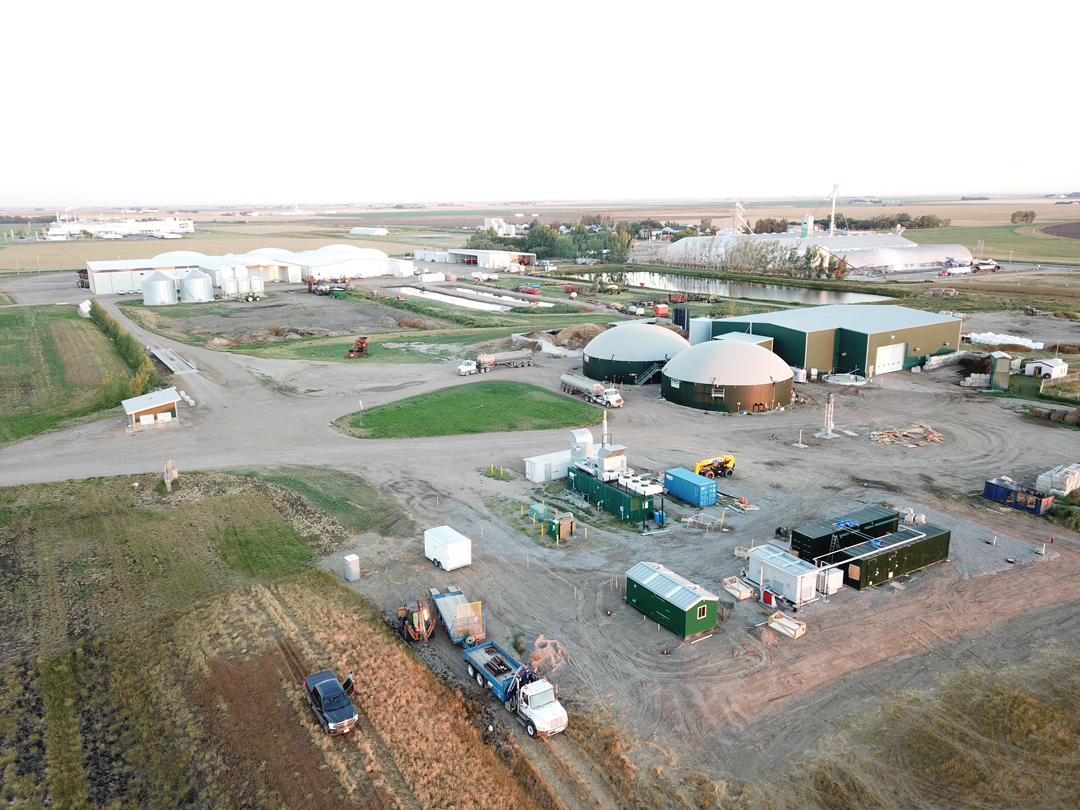SOIL SITUATION VARIES
BY GEOFF GEDDES • PHOTO COURTESY OF GOVERNMENT OF ALBERTA
If you like to read soil moisture maps in bed (and who doesn’t?), the latest of these may keep you up at night. Recent Government of Alberta precipitation and accumulated moisture maps picture zones of potential trouble. While they aren’t cause for panic, some spots warrant a closer look.
MOISTURE MATTERS
“I don’t trust projections,” said Ralph Wright, manager of the Province’s Agro-meteorology Applications and Modelling Unit. He spoke with GrainsWest in early November. “The history of weather and climate in this province is highly variable, because Alberta is never all one or the other.”
Wright did acknowledge unsettling recent precipitation patterns may cause concern. From 2020 to 2023, he said, areas from Calgary to Red Deer and up to Whitecourt suffered once-in-50-year lows for a four-year period. The same applied in the northeast and Peace Region. During that time, Red Deer lost about 400 millimetres of moisture, while the southeast and southwest corners were down 500 to 600 millimetres.
“Wet years replenish surface water supplies—rives, lakes, wetlands, dugouts, soil moisture, etc.—if they are wet enough or you have a few in a row. They bring up groundwater as well,” said Wright. The last such year in Alberta was 2016. “October marked the beginning of Alberta’s dry season, which normally lasts until March.
In the south, 20 per cent of precipitation comes between October and March, and the figure is about 35 per cent for the Peace Region. You can’t typically expect to make up a big moisture deficit over the winter, but even an average snowpack would get everyone off to a good start for spring. Of course, Mother Nature gives you what she wants, not necessarily what you need, so we’ll have to wait and see.”
The soil moisture foundation for 2025 continues to form. “Soil moisture is our bank account against dry weather,” said Wright. “Fall is when we start building reserves for next year, and crops need a good start in the spring; they will take whatever they can get during the hottest days of summer. This has a bearing on yield. If you draw two lines from Calgary, one to Lloydminster and one to the southeast corner of Alberta, most of those areas are doing pretty well for soil moisture.”
The variability of Alberta weather can provide surprises for farmers. Last winter, the snow disappeared early, which prompted the wringing of hands about the 2024 growing season. “How quickly things change,” said Wright. “I was worried, too, and then May came, the heavens opened up, and people breathed a sigh of relief.”
WAITING AND WORRYING
Weather and soil moisture conditions can make or break a year for farmers. “The concern now is low soil moisture going into winter, which could affect seeding, crop emergence and uniformity come spring,” said Ruoxi Xia, agronomy extension specialist with Alberta Grains. “Heat and drought stress during the grain filling stage can lead to thin kernels in cereal crops.”
In mid to late July this year, we experienced 30 C-plus heat with minimal rain. This heat wave coincided with the grain filling period in many regions, which resulted in thin kernels. “Drought is one of the top limiting factors for crop production, so it is on everyone’s mind,” said Xia. This was evident during Xia’s recent visit to an Acme area farm. Where central Alberta normally receives ample moisture and averages around 100 bu/ac barley, lack of rain cut yield in half. Drought conditions also impacted experimental trials.
In the Oyen area, a lack of moisture led to heat and drought stress that caused low plant height, tiny heads and significant yield reductions.
During an Alberta Grains 2024 Plot2Farm trial just west of Edmonton, grain protein in wheat averaged 18 per cent, much higher than usual. This was a surprise for Xia and her colleagues. They speculated the field was fertilized for a much higher yield target. However, due to drought conditions, the actual yield was much lower, the plants utilized the extra nitrogen to produce more protein.
High grain protein creates challenges in barley. “Brewers and distillers don’t like too much protein in malt barley,” said Xia. Excess protein can cause lower malt extract, so brewers need more malt to produce their beer. It may also negatively affect fermentation, colour development and haze in packaged beer.
Apart from crossing their fingers and toes, how should farmers respond to an absence of moisture?
SPRING INTO ACTION
“If farmers save their own seeds, they should test for germination and vigour, the two main factors that impact emergence and overall crop development the following year,” said Xia.
To mitigate drought impact, there are strategies farmers may consider. One such practice is stubble management to trap snow and increase soil moisture. “Researcher Phillip Harder at the Global Institute for Water Security found that every extra centimetre of stubble height can produce a one millimetre gain of soil moisture,” said Xia. “An additional 25 centimetres of snow on a field produces about an inch of moisture and five to seven more bushels per acre of wheat, or seven to nine more for barley.”
The benefits of till versus no-till on soil moisture has been the subject of debate. A study by Ross McKenzie, a former Alberta soil and crop research scientist, found that every pass of tillage caused a loss of half an inch of moisture. Xia cited a farm trial carried out this past year on two fields less than 10 kilometres apart. One was tilled a few passes prior to seeding. The crops grown here were shorter and showed more drought and heat stress. Yet, in the other, where the field was fallow the year before and notill seeded in spring, the crops were taller and less stressed.
As genetics advance, farmers may consider varieties with greater drought tolerance. Varieties listed in the Alberta Seed Guide as performing well under “low yield” conditions are more likely to be resilient to drought. Farmers can also ask their local seed grower or retailer for variety suggestions.
Though not for everyone, early seeding may also help. Xia cited telling results from an early seeding study in southwest Alberta by Brian Beres, an Agriculture and Agri-Food Canada research scientist. “Using spring wheat, he found that a soil temperature of 2 to 4 C improved yield and yield stability.”
In the Grande Prairie region, with a few exceptions, moisture levels are dangerously low. “On the plus side, areas around High Prairie, Slave Lake and Falher are seeing good moisture levels, but north of that there is nothing,” said Bob Chrenek, a councillor with the County of Grande Prairie. “For those in the north, an absence of moisture next year could be devastating. Some of the older farmers have financial reserves, but these challenges are hard on the younger ones, and we need them to stay in the business.”
With his son Matt, Chrenek farms 3,500 acres of canola, peas and malt barley near Grande Prairie. They have adapted farm practices to maximize soil moisture. “Many growers are opting for less tillage or adapting straw management to trap as much moisture as possible,” said Chrenek. “For the latter, the trick is achieving the best soil coverage you can, while still exposing some of the dirt. It’s also good to see farmers talking to each other about what works and what doesn’t.”
He had an additional weather suggestion for the government. “I’d like to see more weather stations in northern Alberta to match what they have in the south. By gathering and analyzing good data, they could help immensely in deciding how to proceed during trying times.”
Chrenek said nobody has thrown in the towel. “Farmers will always remain optimistic. It has been dry before, and it will be dry again. Growers are resilient, and we will get through this.”







Comments